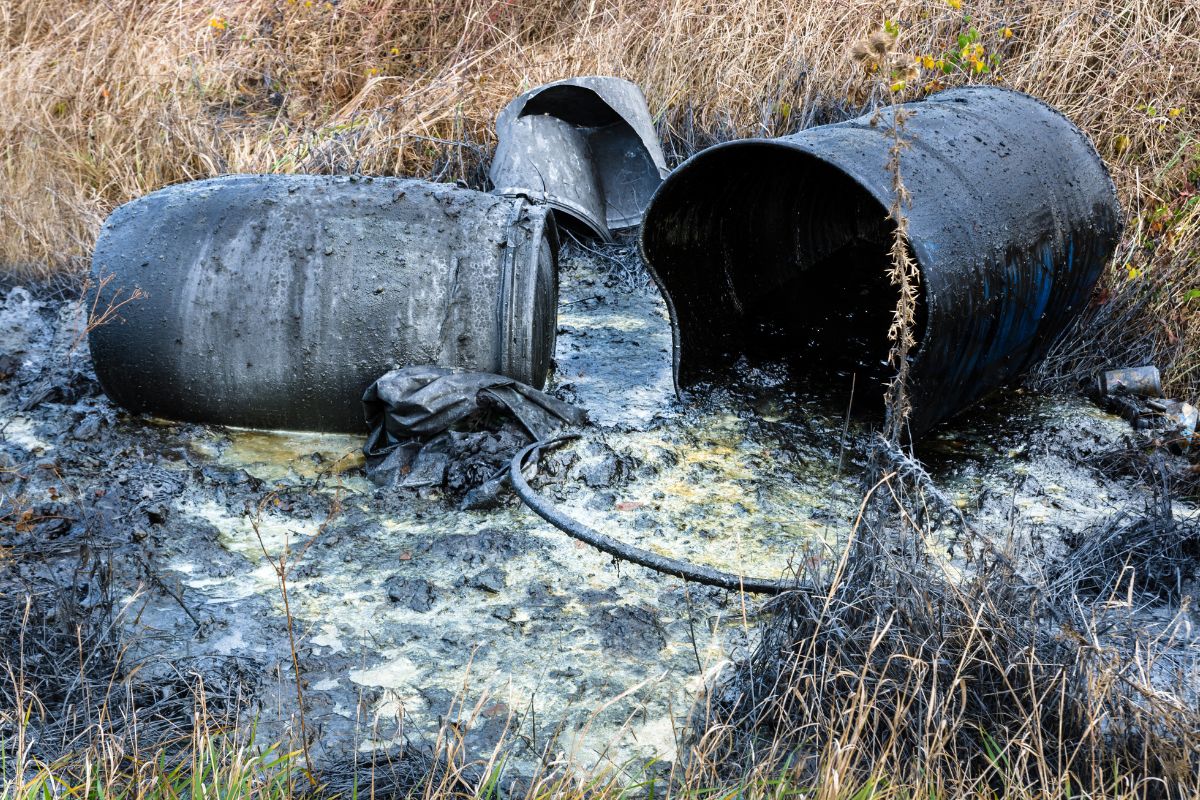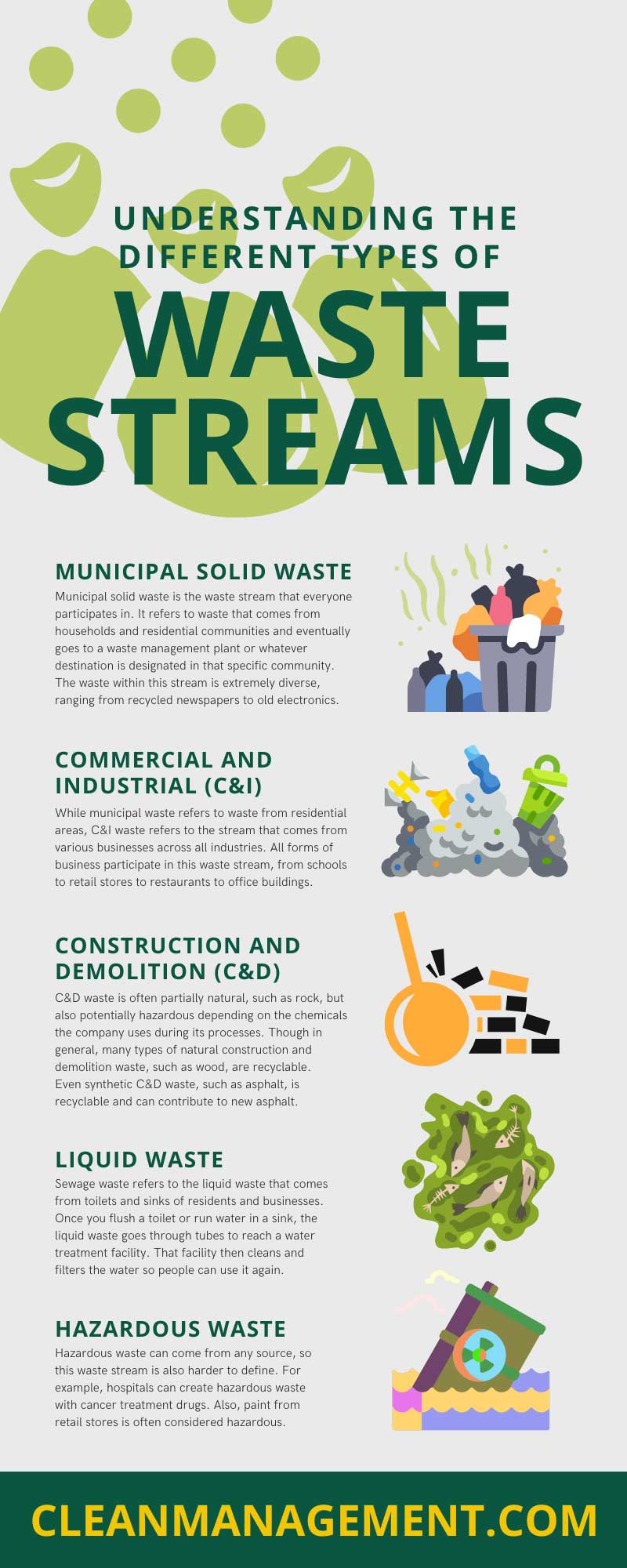Understanding the Different Types of Waste Streams

Not all waste is created equal. For a better understanding of the different types of waste streams and how you play a role in contributing to them, read on.
Waste Stream Definition
Before we can understand the various waste streams, we first need to understand what one is. A waste stream is the complete stream or flow of waste from its creation source—whether that source is residential or industrial—until its final disposal. Final disposal can refer to the recovery or recycling process or other forms of waste management, such as landfill burial or waste-to-energy conversion.
Types of Waste Streams
There are five main types of waste streams: municipal solid waste, commercial and industrial waste, construction and demolition waste, liquid waste, and hazardous waste. Within these, there are subcategories of waste and various smaller waste streams. Some waste streams can overlap, such as when handling hazardous liquid waste. To better understand the five main categories, read on.
Municipal Solid Waste
Municipal solid waste is the waste stream that everyone participates in. It refers to waste that comes from households and residential communities and eventually goes to a waste management plant or whatever destination is designated in that specific community. The waste within this stream is extremely diverse, ranging from recycled newspapers to old electronics.
These diverse types of waste within this large stream create smaller stream paths. While they could all go to the same waste management plant and end up in a landfill together, it’s better that each type of waste create a specific stream path. This way, people can recover or recycle some types of waste—such as glass bottles—and prevent them from wasting space in a landfill.
Commercial and Industrial (C&I)
While municipal waste refers to waste from residential areas, C&I waste refers to the stream that comes from various businesses across all industries. All forms of business participate in this waste stream, from schools to retail stores to restaurants to office buildings.
Since this waste stream incorporates so many starting points, there are many stream paths, similar to those created from municipal solid waste. For example, the paper a school or office recycles is collected, transported to a recycling facility, sorted into appropriate categories, and then shredded. Shredded paper is then turned into pulp, which is then de-inked, dried, and transformed into new paper products. This process represents a full waste stream path.
However, the waste stream path for discarded restaurant food is completely different. Some food waste is scraped right off a plate into a trash bag that goes to a landfill. There, it will sit until it naturally decomposes. To avoid adding this waste to landfills, many areas are partnering with various sustainability organizations and waste management companies. The hope is to create better stream paths that allow restaurants to donate some unused food items or compost some types of food waste. These paths are longer and require more effort, but they are better for the environment.
Construction and Demolition (C&D)
Although the construction and demolition waste stream may have some overlap with the commercial and industrial stream, C&D waste streams are unique. For example, while some aspects of construction may fall into the C&I waste stream—such as discarded blueprints—construction mostly produces waste that requires a unique waste stream.
This is because C&D waste is often partially natural, such as rock, but also potentially hazardous depending on the chemicals the company uses during its processes. Though in general, many types of natural construction and demolition waste, such as wood, are recyclable. Even synthetic C&D waste, such as asphalt, is recyclable and can contribute to new asphalt.
However, if waste isn’t recyclable, then the waste management company must choose the best way to continue the stream path. There are various options depending on the type of waste and what the company can do, such as waste-to-energy, incineration, landfill burial, and more.
Liquid Waste
Unlike the types of waste we mention above, liquid waste can come from various sources. Therefore, we use the state of the matter to define this waste stream, not its source. Overall, there are three main types of liquid waste: sewage, trade waste, and hazardous liquid waste.
Sewage waste refers to the liquid waste that comes from toilets and sinks of residents and businesses. Once you flush a toilet or run water in a sink, the liquid waste goes through tubes to reach a water treatment facility. That facility then cleans and filters the water so people can use it again.
Trade waste is liquid waste from a business that enters the sewage system in that area; however, trade waste comes from something other than toilets and sinks. For example, when a restaurant cleans its kitchen floors with soap and water, that dirty water is put down a drain into the sewer system. Before it reaches the sewer system, though, it goes through filters to remove the excess contaminants and chemicals. After going through those filters, it continues to the appropriate water treatment facility.
Hazardous liquid waste, such as certain solvents and paints, is carefully stored in appropriate containers. A hazardous waste management company would then pick up and transport the containers to a disposal facility, which is most commonly a landfill. Many landfills have a specific area for hazardous liquid waste to protect the surrounding communities and environment.
Hazardous Waste
Hazardous waste can come from any source, so this waste stream is also harder to define. For example, hospitals can create hazardous waste with cancer treatment drugs. Also, paint from retail stores is often considered hazardous.
However, regardless of the source, hazardous waste is stored in containers and facilities that prevent it from hurting the surrounding areas. A waste management company that’s trained to handle hazardous waste will collect the containers and dispose of the waste in an appropriate manner.
Additionally, the disposal method at the end of the stream can vary depending on what hazardous characteristics the waste possesses. For example, you can dispose of some ignitable waste in a landfill. But most local governments require that you dispose of toxic waste, such as chemical waste, through an Environmental Health and Safety office.
Regardless of the source and characteristics, hazardous waste requires specific handling to protect the surrounding community and environment from potential dangers that waste poses. If you have hazardous waste for any reason, you’ll need to hire a waste management company that can safely dispose of it in the proper waste stream.
Your Part in the Waste Streams
As we mentioned above, you participate in various waste streams throughout your day. Even if you’re doing your best to run a zero-waste business or create less waste in your home life, you still contribute to waste streams. However, now that you understand the different types of waste streams, you are better equipped to prevent mishandling your waste.
If you want to ensure that your waste is in the right waste stream, then you can hire Clean Management Environmental Group. We do waste disposal in San Antonio and other areas, getting all types of waste into the proper waste stream. Contact us today!

